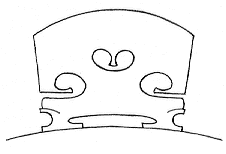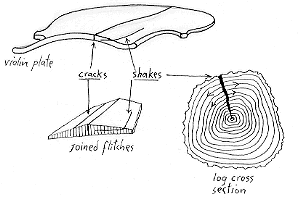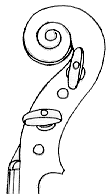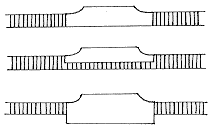ATMOSPHERE
The effects of humidity and dryness on the stringed instruments are critical. Wooden artifacts over 3000 years old, uncovered during arcaeological expeditions in Egypt still show hygroscopic reactions, and can absorb and expel water from the surrounding atmosphere. Wood has a constant affinity for moisture. The amount of water that occupies the cells of wooden objects is constantly varied in its tendency to follow the surrounding air. When the air is dry, wood shrinks and consequently is subjected to damaging inner tensions. When the air is very moist for long periods of time, there is a danger of mould formation and decomposition of the wood fibres. The level of relative humidity which is mostly considered to be ideal for the preservation of wooden objects is 55%. A 30% level of relative humidity for any appreciable length of time will most likely cause cracks in violins. The ideal atmosphere for a violin is of course precisely the one in which the instrument was made, but it is a practical impossibility to keep the instrument perfectly acclimatized. You can avoid major damage to instruments by not placing them too near radiators, or in sun-baked cars. Try to avoid extremely sudden changes in humidity and temperature. Try to store the instrument in a room where the relative humidity is between 45-55%. In the winter months when central heating dryes out the air in buildings, and occasionally frost binds the atmospheric humidity, the wood begins to contract. If the belly and back of the instrument are too tightly glued, and can not open up at the seams where the plates meet the ribs, cracking occurs. It is much easier to repair an open seam than to reglue a crack properly. In summer when there is, more often than not an excess of humidity the wood begins to swell. This swelling of the wood due to the absorption of moisture weakens the structure of the material, causing the already sensitive central part of the relatively thin belly to have less resistance to the enormous forces caused by the taught strings. The combination of these stresses on the belly and the woods varying resistance, in summer causes a higher bridge / lower fingerboard, and the opposite in winter. Another unfortunate effect of summer moisture is the warping and twisting of the neck . The ebony fingerboard and the maple neck, of different densities will swell differently when subjected to moisture, and distortion can start to occur. It is easier to add moisture to the instrument in the winter months than to remove it in the summer months.
 The function of the bridge is to support the strings and to transmit vibrations.
Depending on the cut and shaping of the bridge, and the nature of its wood,
variations of flexibility/stiffness are adjusted which have an important influence
on the
timbre of sound, and resistance to the bow. It is the fine tuning of the
bridge in this way which is the specialty of an experienced violin maker.
The function of the bridge is to support the strings and to transmit vibrations.
Depending on the cut and shaping of the bridge, and the nature of its wood,
variations of flexibility/stiffness are adjusted which have an important influence
on the
timbre of sound, and resistance to the bow. It is the fine tuning of the
bridge in this way which is the specialty of an experienced violin maker.
 The bridge is shaped so that the surface which faces the tailpiece is absolutely
flat, and the surface which faces the fingerboard is arched. It is in fact the
flat surface of the bridge which should be in an upright position in relation
to the belly joint. This is why it appears as though the bridge is leaning towards
the tailpiece. (see figure). This makes structural and functional sense, since
the gradual tendency of the bridge is to warp in the direction of the fingerboard
due to the constant tuning of the strings. The strings should not be allowed
to dig too deeply into the wood on top of the bridge, as this tends to muffle
their sound, and the addition of a thin sheet of parchment under the e-string
is a good idea and in no way dampens the string.
The bridge is shaped so that the surface which faces the tailpiece is absolutely
flat, and the surface which faces the fingerboard is arched. It is in fact the
flat surface of the bridge which should be in an upright position in relation
to the belly joint. This is why it appears as though the bridge is leaning towards
the tailpiece. (see figure). This makes structural and functional sense, since
the gradual tendency of the bridge is to warp in the direction of the fingerboard
due to the constant tuning of the strings. The strings should not be allowed
to dig too deeply into the wood on top of the bridge, as this tends to muffle
their sound, and the addition of a thin sheet of parchment under the e-string
is a good idea and in no way dampens the string.
It is very important to keep the surface of stringed instruments free of colophony ,dirt and dust. Colophony is slightly acid and can when left for long periods of time attack the varnish and adversely affect it. In extreme situations where the rosin and dirt have built up to a considerable extent it can even damp the freedom of vibration of the belly, as it often does when it gets built up on the strings themselves. The musician is better off restricting his cleaning of the instrument to the daily wiping off of the rosin and sweat , and leaving the serious cleaning to an experienced violin maker. Please don´t use commercial "cleaners" on your instrument. They often contain solvents and abrasives which can seriously damage the instrument. The most beautiful examples of classical varnishes are those which have, to a large extent been spared constant polishing. It is really a question of conservation.
 There are two major ways in which wood ruptures. Splits or cracks which are
parallel to the annular rings, and shakes which are perpendicular to them. These
splits and shakes are caused either by shocks and blows or by contraction of
the wood caused by a lack of atmospheric humidity. Shakes are the rarer of the
two, and tend to happen in the seasoning process before the instrument is made.
This is because the initial changes in form of the flitch of wood when it starts
to shrink is in the direction of the annular rings (see fig ). Cracks are a
more common enemy of the musician. When a crack forms or opens it is very important
not to touch it . Fingers (even clean ones ) are covered in grease and sweat
which can easily get into the crack and ruin the glues chances of making a strong
bond, as well as making the crack less likely to be invisible after the repair.
If a crack is seriously affecting the structure of the instrument (near sound
post, bassbar or ff holes), the strings should be let down immediately. A few
cracks can be repaired from the outside, such as small cracks near the ff holes,
but mostly the instrument must be opened and the cracks properly reinforced
on the interior. Cracks are reinforced with 1. studs or small diamonds of wood
glued onto the inside surface along the crack 2.patches which are imbedded into
the original interior wood and 3. Various patches of cloth and parchment. Parchment
and other skin patches must be used with great care to avoid distortion of the
plate, because when skin dryes it shrinks quite violently. Through centuries
of experience it has been found that these reinforcements do not appreciably
affect adversely the sound of the instrument.
There are two major ways in which wood ruptures. Splits or cracks which are
parallel to the annular rings, and shakes which are perpendicular to them. These
splits and shakes are caused either by shocks and blows or by contraction of
the wood caused by a lack of atmospheric humidity. Shakes are the rarer of the
two, and tend to happen in the seasoning process before the instrument is made.
This is because the initial changes in form of the flitch of wood when it starts
to shrink is in the direction of the annular rings (see fig ). Cracks are a
more common enemy of the musician. When a crack forms or opens it is very important
not to touch it . Fingers (even clean ones ) are covered in grease and sweat
which can easily get into the crack and ruin the glues chances of making a strong
bond, as well as making the crack less likely to be invisible after the repair.
If a crack is seriously affecting the structure of the instrument (near sound
post, bassbar or ff holes), the strings should be let down immediately. A few
cracks can be repaired from the outside, such as small cracks near the ff holes,
but mostly the instrument must be opened and the cracks properly reinforced
on the interior. Cracks are reinforced with 1. studs or small diamonds of wood
glued onto the inside surface along the crack 2.patches which are imbedded into
the original interior wood and 3. Various patches of cloth and parchment. Parchment
and other skin patches must be used with great care to avoid distortion of the
plate, because when skin dryes it shrinks quite violently. Through centuries
of experience it has been found that these reinforcements do not appreciably
affect adversely the sound of the instrument.
 The fingerboard
is traditionally made of ebony, although in the baroque era it was generally
made of a softer wood veneered with ebony. I wouldnt be surprised to see
the re-introduction of this practice in years to come, as a result of ecological
realities. Ebony is extremely resistant to wear and takes a beautiful finish
without polish. Although its primary function is to provide a surface to
stop the strings against , it has quite an effect on the vibration of the whole
instrument due to its weight and shape. The end of the board which protrudes
over the body of the instrument vibrates very strongly at its own resonance
and consequently affects considerably the main body resonances of the instrument.
It is a good idea to note the tone at which the fingerboard vibrates if one
is particularly concerned with keeping the sound unchanged when a new fingerboard
is fitted. The lateral curve of the board follows the curvature of the bridge
more or less (the bridge curve is often slightly modified). The longitudinal
hollowing of the board is neccessary to prevent string buzzing. The reason for
this hollowing is that a vibrating string, especially the ones with more mass
and thickness, have a shape as shown in fig ?. If the fingerboard ever comes
loose, even if it doesnt fall off, immediately release the tension of the
strings to avoid warpage and distortion of the neck. The neck is really very
flimsy without the fingerboard.
The fingerboard
is traditionally made of ebony, although in the baroque era it was generally
made of a softer wood veneered with ebony. I wouldnt be surprised to see
the re-introduction of this practice in years to come, as a result of ecological
realities. Ebony is extremely resistant to wear and takes a beautiful finish
without polish. Although its primary function is to provide a surface to
stop the strings against , it has quite an effect on the vibration of the whole
instrument due to its weight and shape. The end of the board which protrudes
over the body of the instrument vibrates very strongly at its own resonance
and consequently affects considerably the main body resonances of the instrument.
It is a good idea to note the tone at which the fingerboard vibrates if one
is particularly concerned with keeping the sound unchanged when a new fingerboard
is fitted. The lateral curve of the board follows the curvature of the bridge
more or less (the bridge curve is often slightly modified). The longitudinal
hollowing of the board is neccessary to prevent string buzzing. The reason for
this hollowing is that a vibrating string, especially the ones with more mass
and thickness, have a shape as shown in fig ?. If the fingerboard ever comes
loose, even if it doesnt fall off, immediately release the tension of the
strings to avoid warpage and distortion of the neck. The neck is really very
flimsy without the fingerboard.
The pegs keep the strings taut at the correct pitch but are at the same time able to be adjusted, by means of their conical shape. The shape of the pegs and the holes into which they fit is adjusted by a special reamer to accurately bore out the holes and a peg-shaver which forms the peg shaft. Badly fitting pegs are a nuisance and must be adjusted by a skilled workman. The pegs and/or holes become worn and distorted with continual use and the holes themselves become bigger through constant abrasion. There are three main techniques for re-adjustment. 1) Lightly re-reaming the peghole and fitting a larger peg. 2) When the pegholes haven¥t become too worn, a light reshaping of the peg shank is sufficient. 3) Bushing the peg holes with new wood.
 New pegs and/or bushing will probably be the best solution if there isn¥t
enough peg shank between the peg-head and the side of the pegbox (10-12mm f.violin).
Care should be taken to avoid compounds and various other materials such as
chalk which are abrasive. They will shorten the life of pegs and pegholes through
premature wear. Too much cramping of string ends in the peg box can cause excessive
wear on the pegs and holes. It can also be quite dangerous to wind too much
string on the pegs. Sometimes the excess string gets wedged underneath the peg
against the floor of the pegbox and causes cracks in the back of the pegbox.
New pegs and/or bushing will probably be the best solution if there isn¥t
enough peg shank between the peg-head and the side of the pegbox (10-12mm f.violin).
Care should be taken to avoid compounds and various other materials such as
chalk which are abrasive. They will shorten the life of pegs and pegholes through
premature wear. Too much cramping of string ends in the peg box can cause excessive
wear on the pegs and holes. It can also be quite dangerous to wind too much
string on the pegs. Sometimes the excess string gets wedged underneath the peg
against the floor of the pegbox and causes cracks in the back of the pegbox.
 The saddle prevents the tailgut from digging into the soft endgrain of the belly,
but its height above the belly can also change the angle of the strings over
the bridge. It is sometimes only groped into the belly halfway through the thickness
of the plate, sometimes flush with the endblock and in some cases cut into the
lower ribs as well. These are only idiosyncracies of different styles of making
and are of no real practical consequence. The saddle must not become too tight
in its recess. It can easily become too tight when the belly shrinks with time,
and as it will not give way it will cause nasty cracks in the belly, perpendicular
to the ends of the saddle. If the saddle becomes too tight it must be removed
and shortened by a violin maker.
The saddle prevents the tailgut from digging into the soft endgrain of the belly,
but its height above the belly can also change the angle of the strings over
the bridge. It is sometimes only groped into the belly halfway through the thickness
of the plate, sometimes flush with the endblock and in some cases cut into the
lower ribs as well. These are only idiosyncracies of different styles of making
and are of no real practical consequence. The saddle must not become too tight
in its recess. It can easily become too tight when the belly shrinks with time,
and as it will not give way it will cause nasty cracks in the belly, perpendicular
to the ends of the saddle. If the saddle becomes too tight it must be removed
and shortened by a violin maker.
 The nut is shaped to keep the distance between the strings comfortable, and
to support the strings at a convenient height from the fingerboard. It makes
quite a bit of difference to the comfortable playing of an instrument that the
nut is well rounded and doesn¥t have protrusions that might be annoying.
It is also quite important that the grooves are well shaped so that the strings
will be able to slip over the nut easily and that they don¥t buzz. Graphite
is the preferred lubricant for the grooves of the nut because it is black and
seems to work quite nicely with the ebony.
The nut is shaped to keep the distance between the strings comfortable, and
to support the strings at a convenient height from the fingerboard. It makes
quite a bit of difference to the comfortable playing of an instrument that the
nut is well rounded and doesn¥t have protrusions that might be annoying.
It is also quite important that the grooves are well shaped so that the strings
will be able to slip over the nut easily and that they don¥t buzz. Graphite
is the preferred lubricant for the grooves of the nut because it is black and
seems to work quite nicely with the ebony.
One of the things that allows an instrument to sound with maximum efficiency and quality is the way in which it is set up. The term "set-up" implies several variables, including: The elevation, or the distance from the surface of the front to an imaginary continuation of the level of the fingerboard. The elevation defines the angle of the strings over the bridge and consequently affects the force exerted on the front of the instrument by the strings. The distance of the strings from the fingerboard, influencing playability and resistance. Other aspects of the set-up include, the shape and height of the saddle and nut, distance between strings and choice of strings. The aspects of the set-up which have a direct and dramatic influence on the sound and playability of the instrument are: The cut of the bridge the position tightness and fit of the sound post, the string height above the fingerboard and the choice and/or condition of the strings.
The tailpiece has the sole function of holding the strings at a certain distance from the bridge. It has however a natural inherent vibration(which you can clearly hear if you tap it with the strings damped) The distance of the tailpiece from the bridge, the mass of the tailpiece and also the length of the tailgut, influence and tune its frequency of vibration and therefore change the degree to which the tailpiece absorbs energy from certain modes of vibration of the violin body. The tailgut used to be made of gut, and often still is, but the inconvenience that gut causes by its constant change with variations of humidity, has caused it to be replaced by synthetic materials which generally keep the instrument better in tune.
Made in RapidWeaver


